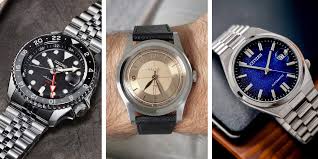Mechanical watches are more than just timekeeping tools—they’re pieces of history, craftsmanship, and art. Whether you're a first-time watch owner or a curious enthusiast, learning how to properly wind a watch is a crucial part of keeping it accurate and maintaining its longevity.
In this guide, we’ll walk you through everything you need to know about winding a watch—from understanding the types of mechanical watches to mastering the step-by-step winding process, and even learning how to avoid common mistakes that can damage your timepiece.
What Does It Mean to Wind a Watch?

Winding a watch refers to the process of tightening the mainspring inside the watch movement, which stores energy and powers the watch. In manual mechanical watches, winding must be done by hand. Automatic (or self-winding) watches, on the other hand, wind themselves as you wear them, thanks to a rotor that moves with your wrist motion—but they can also be manually wound if needed.
Winding is essential to keep the watch running and maintaining accurate time. Neglecting to wind a manual watch will cause it to stop, while automatic watches can run down if left unworn.
Types of Watches and Winding Requirements

Before we get into how to wind a watch, it’s important to identify what type of watch you own:
1. Manual Mechanical Watches
-
Require daily or near-daily winding.
-
Usually have a power reserve of 24 to 48 hours.
-
Must be wound by turning the crown (the small knob on the side of the watch).
2. Automatic (Self-Winding) Mechanical Watches
-
Wound by the movement of your wrist during regular wear.
-
Can also be wound manually using the crown.
-
Ideal for daily wearers but may need manual winding if not worn regularly.
3. Quartz Watches
-
Powered by a battery and do not require winding.
-
Some high-end models (like Seiko’s Spring Drive or Citizen Eco-Drive) may have unique energy systems, but they generally don’t need winding.
If your watch ticks smoothly with a sweeping second hand and doesn’t use a battery, you likely have a mechanical watch—manual or automatic.
How to Wind a Manual Mechanical Watch

Here is a step-by-step guide to winding a manual watch:
Step 1: Remove the Watch from Your Wrist
Avoid winding the watch while it’s on your wrist. Doing so can put pressure on the crown stem at an awkward angle, potentially damaging the movement or crown mechanism.
Step 2: Locate the Crown
The crown is typically on the right-hand side of the watch case. It may be in a pushed-in position or unscrewed, depending on the watch model.
Step 3: Pull Out the Crown (If Necessary)
Some manual watches require the crown to be pulled out to the first position for winding. However, many allow winding while the crown is pushed in. Refer to your watch’s manual if you're unsure.
Step 4: Turn the Crown Clockwise
Gently turn the crown in a clockwise direction (away from you). You should feel some resistance and hear a soft clicking sound. This is the mainspring tightening.
-
How many turns?
Most manual watches require 20 to 40 full turns to fully wind. The number can vary depending on the watch model and its power reserve. -
How do I know when to stop?
You’ll feel increased resistance when the mainspring is fully wound. Do not force the crown past this point, as over-winding can break the mainspring or damage the movement.
Step 5: Push the Crown Back In (If Pulled Out)
After winding, push the crown back to its original position. If your crown screws in (as with many water-resistant watches), screw it down carefully to ensure water resistance is maintained.
How to Wind an Automatic Watch
Automatic watches are more flexible. If you wear yours daily, you may never need to wind it manually. But if it's stopped or not worn for a while, here’s how to wind it:
Step 1: Take the Watch Off Your Wrist
Just like with manual watches, wind your automatic off-wrist to protect the crown stem.
Step 2: Find and Unscrew the Crown (If Applicable)
Some automatic watches have a screw-down crown for water resistance. Unscrew it gently by turning it counterclockwise until it pops out.
Step 3: Wind the Watch
Turn the crown clockwise slowly and smoothly. Around 30 to 40 turns are usually sufficient to fully wind an automatic watch. You’ll feel resistance increasing, but most automatic watches have a slipping clutch mechanism to prevent over-winding.
Step 4: Gently Push and Screw the Crown Back In
Once done, press the crown back in and screw it down if needed. This ensures dust and water resistance are preserved.
Tips and Best Practices for Winding Watches
Winding a watch isn’t just about keeping it ticking—it’s about doing it right to preserve the life of your timepiece. Here are some practical tips:
✅ Wind Your Watch at the Same Time Every Day
This helps keep it running accurately and forms a habit. Morning is ideal, especially for watches with a 24-48 hour power reserve.
✅ Don’t Over-Wind
This is the most common mistake. Always stop when you feel resistance. Automatic watches often have built-in mechanisms to prevent over-winding, but manual ones do not.
✅ Use a Watch Winder (Optional for Automatics)
If you own several automatic watches and don’t wear them all regularly, a watch winder can keep them running and prevent the hassle of resetting time and date.
✅ Avoid Winding Under Water
Even with water-resistant watches, don’t wind or operate the crown while submerged. It can allow water to enter the case.
✅ Service Your Watch Regularly
Even with perfect winding technique, a mechanical watch needs professional servicing every 3 to 5 years to clean, oil, and check internal components.
Frequently Asked Questions (FAQs)
Q1: Can I over-wind my watch?
Yes, manual watches can be over-wound if you force the crown beyond the point of resistance. Automatic watches have a slipping spring to prevent over-winding, but it’s still best to stop after 30-40 turns.
Q2: How often should I wind my manual watch?
Daily is ideal. Most manual watches have a power reserve of about 40 hours, so winding once every 24 hours keeps it running smoothly.
Q3: My watch stopped. Is it broken?
Not necessarily. If it’s a manual or automatic watch, it likely just needs winding. Try winding it and setting the time again.
Q4: Why doesn’t my automatic watch start after winding?
Sometimes the movement needs a little help. Gently shake the watch or wear it for a few minutes to get the rotor moving.
Q5: Should I wind my automatic watch even if I wear it every day?
You don’t have to, but giving it a few turns in the morning can ensure the mainspring stays at peak tension, especially if your daily activity level is low.
Final Thoughts
Winding a watch might seem old-fashioned, but it's part of the charm of owning a mechanical timepiece. With a bit of care and attention, the process becomes second nature—and even meditative. Whether you’re starting a collection or maintaining a family heirloom, winding your watch the right way ensures it ticks faithfully for years to come.
Mechanical watches connect us to a time when craftsmanship mattered. By learning how to wind one properly, you're not just keeping time—you're keeping tradition alive.


